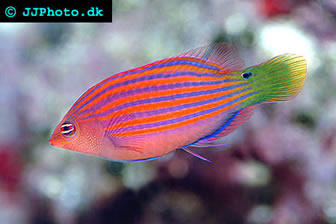Sixline Wrasse
Pseudocheilinus hexataenia
Common name: Sixline Wrasse
Scientific name: Pseudocheilinus hexataenia
Max size: 4 in / 10 cm
pH: 8.1-8.4
Salinity: 1.020-1.025
Temperature: 72-78ºF (22-26°C)
The Sixline wrasse is a beautiful fish. It is popular in the aquarium trade and is readily available. If your local fish store doesn't have it in store they should be able to order it for you, or you can order it yourself via Internet. Please observe however that this is a poor shipper and that live arrival guarantees usually don't cover this species.
The Sixline wrasse has a purple body with six orange lines running horizontally across the upper half. The top of the dorsal fin is also orange. They have red eyes white two white stripes on them.
The Sixline wrasse can be kept as a solitary fish but you can also keep several specimens together in larger aquariums as long as they are introduced to the tank at the same time. They are rather aggressive and should only be kept with other semi-aggressive species such as angels and tangs. They can be very aggressive toward other wrasse species. Introduce more docile fish to the tank before adding Sixline wrasse.
Sixline wrasse is suitable for reef setups but is not 100% reef safe as it will eat small invertebrates and especially small delicate shrimps. They do however also help you keep the aquarium in good condition by eating and thereby controlling unwanted organisms like pyramidellid snails, commensal flatworms, and bristleworms.
This species can be quite sensitive when first introduced to an aquarium but is rather hardy once it has become established. Sixline wrasses should be given at least 4 hours for acclimatization before they are released into a tank. The first thing the wrasse will do is to swim down to the bottom and bury itself. After that, you might not see your precious Sixline wrasse for days. It will spend less and less time hiding in the sand as it becomes more and more at home in the tank. It will always sleep buried in the sand and escape down into the sand when spooked.
Once established it is a hardy fish suitable for intermediate and advanced marine fish keepers.
The Sixline wrasse originates from the Indo Pacific Ocean and can be found from the Red Sea down to South Africa and eastwards to the Hawaiian and Tuamoto islands. This wrasse can be encountered as far north as Japan and as far south as Australia.
Sixline wrasse care and aquarium setup:
The Sixline wrasse should be kept in aquariums no smaller than 20 gallon / 80 L. It is important that you decorated your aquarium so that your Sixline wrasse feels safe if you want it to thrive and spend a lot of time out in the open. Decorating an aquarium for wrasses is about recreating their natural environment and providing them with enough hiding places to feel safe. Sixline wrasses that don't feel safe will become very shy and spend almost all of their time hiding. It can also cause stress which makes them more susceptible to disease.
The bottom of the tank should be covered with a layer of sand that is at least 3 in / 7.5 cm deep. The sand bed needs to be at least that deep to allow the Sixline wrasse to bury in the sand to sleep and seek shelter. The tank should contain an ample supply of hiding places such as caves and overhangs. The best material for caves and hiding places is live rock.
The Sixline wrasse prefers a well lit aquarium. Make sure that you keep the water quality high and stable. This species is an excellent jumper and it is necessary to keep the aquarium well covered to prevent you Sixline wrasse from jumping to its death. This species is best kept in a reef aquarium or an "FOWLR" aquarium.
Ideal conditions for the Sixline wrasse is pH 8.1-8.4, salinity 1.020-1.025, and temperature 72-78ºF (22-26°C).
Feeding Sixline Wrasse
Feeding the Sixline wrasse is easy as they will accept most food types. In the wild they eat small invertebrates. Give them a varied diet consisting of live food, frozen food, chopped up sea food and flake food. Flake food or pellets can be a good and convenient base for the diet but should always be complement with other food as well. Feed your Sixline wrasse at least 3 times a day.
Breeding Sixline Wrasse
We have no information on how to breed this species in an aquarium. Sexing Sixline wrasse is possible as males are larger and have more intense colors.
Wrasse Articles:
Bird Wrasse – Gomphosus varius
Dragon Wrasse - Novaculichthys taeniourus
Harliquin Tuskfish – Coerodon fasciatus
Hogfish - Information about Hogfish
Neon Wrasse – Halichoeres melanurus
Ornate Wrasse – Halichoeres ornatissimus
Queen Coris – Coris frerei
Radient Wrasse – Halichoeres iridis
Spanish Hogfish – Bodianus rufus
Striated Wrasse – Pseudocheilinus evanidus
Yellow Coris – Halichoeres chrysus
Line Wrasses:
Fourline Wrasse – Pseudocheilinus tetrataenia
Eightline Wrasse – Pseudocheilinus octotaenia
Fairy Wrasses:
Exquisite Fairy Wrasse – Cirrhilabrus exquisitus
Lubbock's Fairy Wrasse – Cirrhilabrus lubbocki
Scott's Fairy Wrasse – Cirrhilabrus scottorum
Solar Fairy Wrasse – Cirrhilabrus solorensis
Flasher Wrasses:
Carpenter's Flasher Wrasse – Paracheilinus carpenteri
Dot-and-Dash Flasher Wrasse – Paracheilinus lineopunctatus
Filamented Flasher Wrasse – Paracheilinus filamentosus
McCosker's Flasher Wrasse – Paracheilinus mccoskeri

